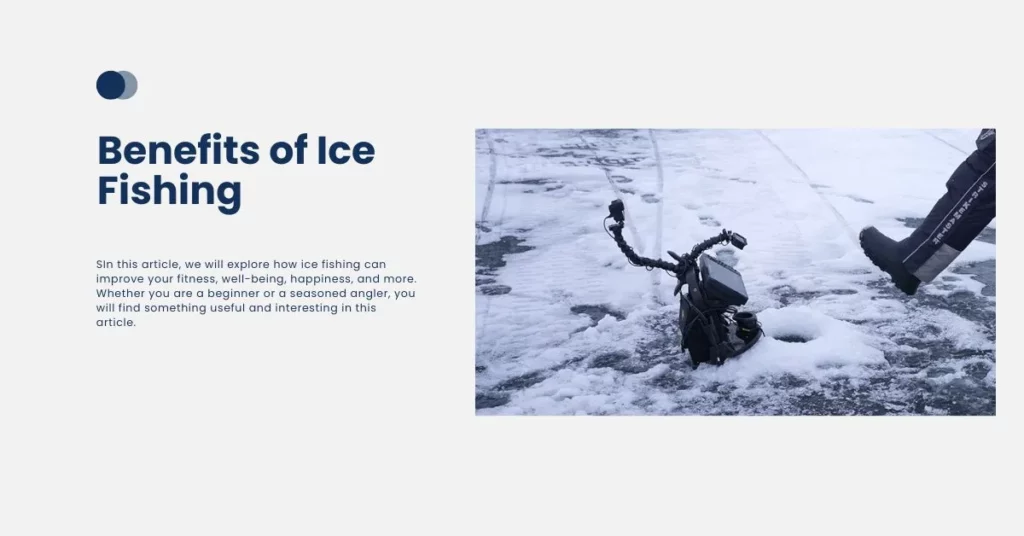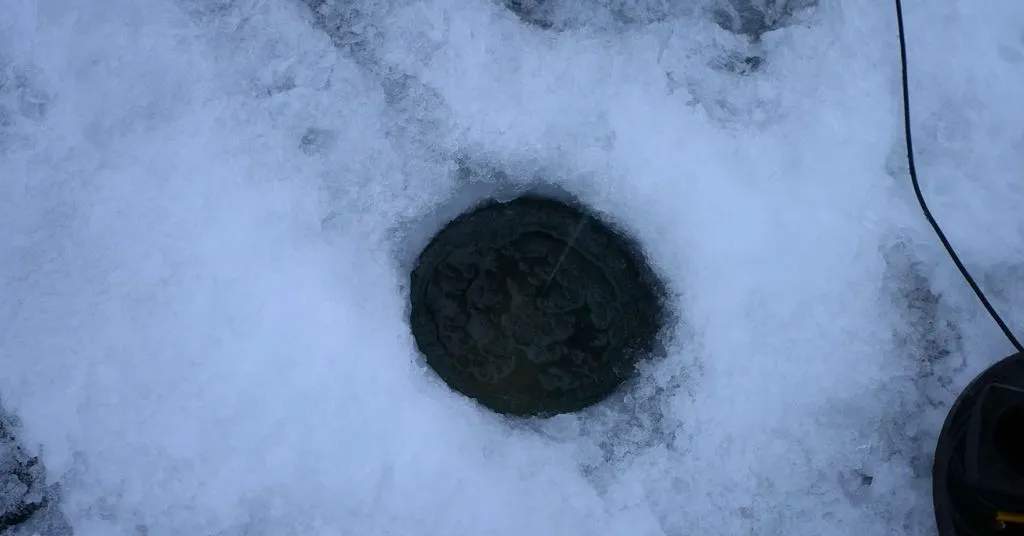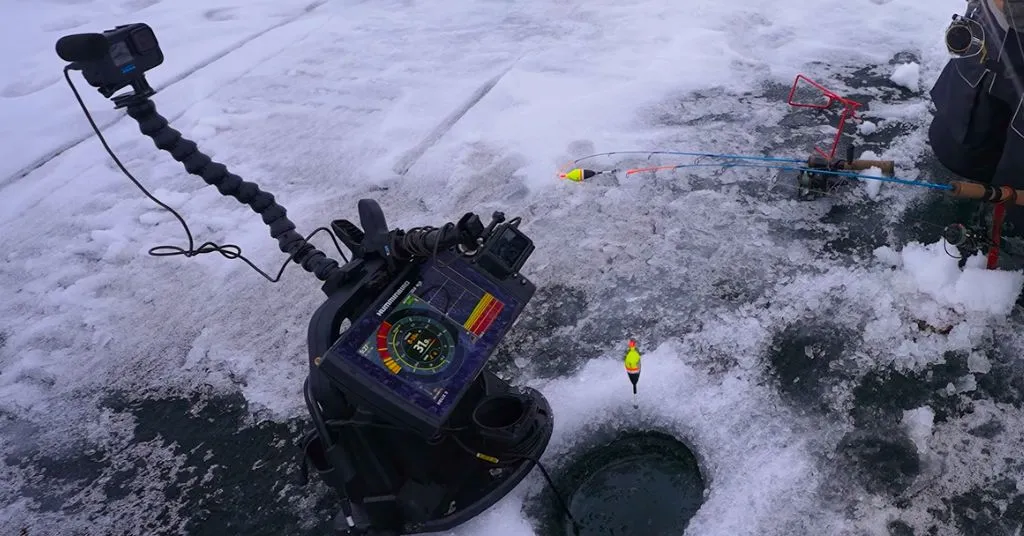
Did you know that there are a lot of benefits of ice fishing for your physical and mental health?
In this article, we will explore how ice fishing can improve your fitness, well-being, happiness, and more. Whether you are a beginner or a seasoned angler, you will find something useful and interesting in this article.
So, let’s dive into the benefits of ice fishing and how you can make the most of this amazing hobby.
What is Ice Fishing?

Ice fishing, a winter activity that involves catching fish through a hole in the frozen surface of a water body, stands as a unique and challenging endeavor.
Distinguished by its reliance on special equipment, techniques, and safety precautions, ice fishing serves purposes ranging from recreation to sport and even subsistence.
Historical and Cultural Roots of Ice Fishing
The practice of ice fishing has deep historical and cultural roots, dating back centuries and spanning various cold regions. Indigenous peoples, such as the Inuit, Scandinavians, Russians, and Native Americans, initially engaged in ice fishing as a means of survival.
Over time, it evolved into a popular winter activity, gaining widespread acceptance in North America and Europe. Today, it has even transitioned into a competitive sport, featuring tournaments and championships worldwide.
Benefits Beyond the Catch
The allure of ice fishing extends beyond the thrill of catching fish. Engaging in this winter activity offers a spectrum of benefits, including physical exercise, mental health enhancement, the joy of good eating, exposure to cold conditions, stress relief, opportunities for family bonding, and character building.
Physical Benefits of Ice Fishing
Ice fishing is not merely a passive hobby; it demands physical engagement and movement. Drilling holes, checking tip-ups, hauling gear, and battling with fish all contribute to a workout that can burn calories, build muscle, improve cardiovascular health, and boost metabolism.

Additionally, spending time in the cold can strengthen the immune system, prevent seasonal affective disorder, and reduce inflammation.
Staying Safe on the Ice
To fully enjoy the physical benefits, safety is paramount. Dressing appropriately in layers, wearing insulated boots and gloves, and covering exposed skin are crucial steps. Staying hydrated, consuming nutritious snacks, and avoiding alcohol help maintain well-being.
Regularly checking ice thickness, steering clear of cracks and weak spots, and carrying safety equipment ensure a secure ice fishing experience.
Mental Benefits of Ice Fishing
The serene and peaceful environment of ice fishing contributes significantly to mental well-being and stress reduction. Connecting with nature, appreciating its beauty, and observing wildlife create a tranquil atmosphere.
The challenge and sense of accomplishment, particularly when landing a trophy fish, stimulate the brain, improve concentration, and enhance creativity.
Therapeutic Aspects
Ice fishing has been used as a therapeutic tool for veterans, people with disabilities, and individuals dealing with mental disorders.
Testimonials highlight its positive impact on happiness, satisfaction, and self-esteem, aiding those battling depression, anxiety, and addiction.
Choosing the Right Gear

A successful ice fishing experience hinges on selecting the right gear and equipment. Fundamental items include an auger, shelter, rod and reel, line, lure or bait, tip-up, and sled. The choice of gear depends on factors like target species, ice conditions, weather, and personal preference.
Tips for Choosing Gear
- Choose an auger that is easy to use and reliable, tailored to ice thickness.
- Opt for a shelter that combines comfort, spaciousness, and portability.
- Select a rod and reel that is compatible, durable, and sensitive.
- Use a strong, abrasion-resistant, and low-visibility line.
- Match the lure or bait to the natural food source, water depth, and fish behavior.
- Ensure a sturdy, visible, and adjustable tip-up.
- Utilize a lightweight, spacious, and easy-to-pull sled.
Top Gear Recommendations
Based on ratings, reviews, and the expertise of the writer, Mukarim Zargar, a seasoned camping expert, the following gear is recommended:
- Auger: ION X 40V Electric Ice Auger
- Shelter: Eskimo QuickFish 3 Pop-Up Ice Shelter
- Rod and Reel: Shakespeare Ugly Stik GX2 Ice Fishing Combo
- Line: Sufix 832 Ice Braid
- Lure or Bait: Rapala Jigging Rap
- Tip-up: Frabill Pro Thermal Tip-Up
- Sled: Shappell Jet Sled
These recommendations ensure a successful and enjoyable ice fishing experience, combining quality, functionality, and personal experience.
Final Thoughts
The benefits of ice fishing extend far beyond the thrill of the catch. Engaging in this winter activity promotes physical fitness, burning calories, building muscle, and boosting cardiovascular health.
Simultaneously, it fosters mental well-being by providing a serene environment for stress reduction, nature appreciation, and a sense of accomplishment. Ice fishing has proven therapeutic, aiding individuals in overcoming mental health challenges.
Selecting the right gear, as recommended by experts, ensures a seamless and enjoyable experience, making ice fishing a holistic winter adventure that taps into physical, mental, and cultural dimensions.
Historical roots trace back to the Inuit, Scandinavians, Russians, and Native Americans, showcasing its adaptive journey from a necessity to a pastime.
Frequently Asked Questions
Is ice fishing safe?
Ice fishing can be safe if proper precautions are taken. Always check the thickness of the ice before venturing out, avoid areas with cracks or weak spots, and carry safety equipment such as ice picks and a life jacket. Dress warmly in layers and be aware of weather conditions to ensure a safe and enjoyable experience.
What gear is essential for ice fishing?
Essential gear for ice fishing includes an auger for drilling holes, a shelter for protection against the cold, a rod and reel, a suitable line, bait or lures, a tip-up for flagging bites, and a sled for transporting equipment. Choosing the right gear depends on factors like the target fish species, ice conditions, and personal preferences.
How does ice fishing contribute to physical fitness?
Ice fishing involves various physical activities such as drilling holes, checking tip-ups, hauling gear, and battling with fish. These activities can contribute to burning calories, building muscle, improving cardiovascular health, and boosting metabolism. Additionally, spending time outdoors in the cold can strengthen the immune system and reduce inflammation.
Can ice fishing be therapeutic for mental health?
Yes, ice fishing has been used as a form of therapy for individuals dealing with mental health issues. The peaceful and serene environment promotes mental well-being, reduces stress, and provides a sense of accomplishment. Testimonials highlight its positive impact on happiness, satisfaction, and self-esteem, making it a valuable activity for mental health.
What are the best practices for staying safe while ice fishing?
Staying safe during ice fishing involves dressing appropriately in layers, wearing insulated boots and gloves, and covering exposed skin. It’s essential to stay hydrated, consume nutritious snacks, and avoid alcohol. Regularly check the ice thickness, steer clear of cracks and weak spots, and carry safety equipment such as ice picks and a life jacket. Be aware of the signs and symptoms of hypothermia and frostbite, and seek medical attention if needed.
